At the Olympics, countries like Kenya have won umpteen gold medals in athletics, while others, like India, have just 28. Perhaps that's why even Olympic bronze medals are treated no less than gold in India.
However, there have been many occasions when an Olympic medal, irrespective of its color, has been the talk of the town for decades. Be it the years of effort invested in it, or the way in which it was won, some of India's triumphs at the quadrennial event have been nothing less than legendary.
Some of these achievements have been converted into interesting movies as well. Be it Bhaag Milkha Bhaag, the official biopic of Milkha Singh, who missed out on a historic Olympic medal by a whisker, or Gold, the story of India's first Olympic medal as a free nation. We also got a glimpse into the pains Saina Nehwal underwent in earning India's first Olympic medal in badminton, through Saina.
Plans are currently underway for a biopic on independent India's first Olympic hero, Major Dhyan Chand. It will be directed by Abhishek Chaubey, known for such movies as Ishqiya, Udta Punjab and Sonchiriya.
However, there have also been some heroic Olympic tales involving Indians, which have not yet gotten their dues on the silver screen. From KD Jadhav to Pullela Gopichand, we have many stories that can inspire generations if they were retold to a new generation by way of cinema or webseries.
We also have a fair share of tragedies involving Indian Olympic legends as well, be it Sushil Kumar's fall from grace or an impatient decision that cost a boxer like Gurcharan Singh both pride and fame.
As India prepares for the Tokyo Olympics, we look at some of the remarkable victories by Indian athletes that deserve a space on either the silver screen or the OTT platforms:
1) The roller coaster Olympic journey of Kashaba Dadasaheb Jadhav
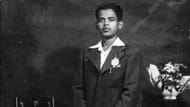
A wrestler gives it his all to win India's first individual Olympic medal. He is brought back with huge fanfare to his village, with a procession of 101 bullock carts escorting him to his home. However, he died penniless and unsung in a motor accident in the town of Karad on 14 August 1984.
This is not a piece of fiction but the actual story of Khashaba Dadashaeb Jadhav. India did win five consecutive gold medals in hockey prior to that, but that was a team sport. Jadhav's medal was India's first individual Olympic medal, and it was certainly not an easy journey.
Jadhav lived a colorful life. Wrestling ran in his blood. He also participated in the Quit India movement against the British and gave shelter to the rebels. The Satara native's talent was spotted, ironically, by British coach Rees Gardner, who recommended he compete at the London Olympics.
Despite having no previous experience of fighting on the mat, KD Jadhav finished in a respectable sixth position on debut. However, it was in Helsinki when he claimed the ultimate glory. Denied a mandatory 30-minute rest period before a bout with Rashid Mammadbeyov, he lost to the Russian and with it, a shot at the gold medal. Nevertheless, he went on to beat wrestlers from Canada, Mexico and Germany to secure bronze.
2) Indian hockey's loss at the Rome Olympics and their redemption in Tokyo
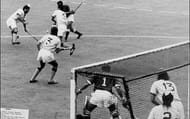
With eight gold medals - the most for any team till date - field hockey has been India's most successful sport at the Olympics. However, none of those gold medals were as remarkable as the one the nation earned at Tokyo in 1964.
India's journey to their seventh gold in hockey is the stuff memorable sports dramas are made of. It had everything from negative publicity and daunting odds to a lack of unity and a dramatic comeback. When the team was preparing for the event, the nation was facing a severe crisis.
It all began with a loss. At the Rome Olympics, India were all set to win their seventh successive gold medal. They once again faced arch rivals Pakistan, who they had routed 1-0 in a clean sweep at Melbourne in 1956.
However, a chance missed by army man Shankar Lakshman changed it all. That one goal proved costly as India lost the finals 0-1, settling for a silver medal at the Rome Olympics. Apart from Milkha Singh's loss, this was one tragedy that hurt Indian fans the most.
Four years later, that miss, coupled with the country's loss in the Indo-China war of 1962, had demoralized the nation considerably. To add to their woes, the media published dozens of negative articles about Indian hockey, doubting whether the team could even cross the league stage.
However, the men bound for the Tokyo Olympics had other plans, and they were quite a mix of personalities. There was Shankar Lakshman himself, who had retribution on his mind. Then there was Udham Singh Kular, a veteran who would be playing his final Olympics, and Captain Haripal Kaushik, a soldier who was as brilliant on the hockey field as he was on the battlefield.
India had a wobbly start, with two draws from two matches. However, they improved quickly enough, and within weeks, made it to the semifinals. They shocked Australia by winning 3-1, and once again faced Pakistan for a third consecutive time in the final.
The final was less of a sporting affair and more akin to a war, with hockey sticks substituting for weapons and Komazawa Hockey Field's turf serving as the battlefield. Sticks and abuse were used to a great extent, and with hot-headed penalty corner specialist Prithipal Singh on the field, things were bound to be aggressive.
However, celebrations began when a shot from Prithipal was obstructed by the defender and a penalty stroke was awarded. Goalkeeper Abdul Hamid was confident it wouldn't get past him, but armyman Mohinder Lal was no pushover. He shot a devious scoop and gave India not only the winning goal but also its seventh Olympic gold medal.
3) Karnam Malleswari and her incredible journey to the Olympic podium
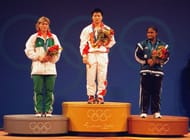
In 2000, Karnam Malleswari became India's first woman to win an Olympic medal, and her journey to that historic triumph in Sydney was nothing short of legendary. How a poor girl from a non-descript village in Andhra Pradesh overcame every obstacle in her way and went on to become a world champion deserves a biopic of its own.
They say, behind every successful man, there is a woman. However, as in the case of the iconic Phogat family, Malleswari's father is the reason she dared to dream big. He believed in giving equal opportunities to his four daughters, and the entire quartet went on to become reputed weightlifters.
However, Karnam stood out the most. At 18, she made a smashing debut at the World Weightlifting Championships in 1993 by winning a historic bronze medal, something unheard of in India. The very next year, she won a gold medal in the same discipline and went on to repeat the feat in 1995 and 1996.
However, Karnam's unexpected rise to fame and her marriage in 1997 raised some doubts about her abilities. Her decision to raise her weight wasn't met with much appreciation, and most critics had written her off.
But where there is a will, like they say, there is a way. Karnam further raised her weight to 69kg and stepped up her training. She lifted 110kg in the snatch category at the Sydney Olympics in 2000 to cement herself in the top three. An impressive lift of 130kg in clean and jerk guaranteed her a historic medal. However, the risk of raising the bar to 137.5kg didn't pay off, and Karnam had to be content with bronze. Had it paid off, she would not only have been India's first female Olympic medalist, but also its first individual gold medalist as well.
4) The Olympic legacy of Pullela Gopichand
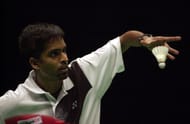
What do Pusarla Venkata Sindhu and Saina Nehwal have in common? Apart from the fact that both established a legacy in Indian badminton, they have also been coached by the same man. Once regarded as India's next major badminton stalwart, Pullela Gopichand instead achieved more Olympic glory as a coach than a player.
Gopichand made his first and only appearance at the Sydney Olympics in 2000, where he equalled Dipankar Bhattacharjee's performance by making it as far as the pre-quarterfinals. However, recurring injuries kept hampering his efforts and he was eventually forced to retire early.
As a coach, he decided to achieve what he couldn't as a player. However, the journey wasn't easy, and he had to mortgage his house in order to open his academy. However, his fortunes changed with the Beijing Olympics in 2008.
Though Gopichand didn't win any medals here, this event marked the beginning of Indian badminton's rise. A rather unknown player then, junior champion Saina Nehwal shocked everyone as she entered the women's singles quarterfinals, where she lost to Maria Kristin Yulianti of Indonesia. In the next edition at London in 2012, Saina went a notch higher and won the bronze medal, the first for any Indian in the event.
However, Gopichand wasn't done yet. He further upped the ante when Pusarla Venkata Sindhu, another one of his students, reached the finals. Though she went down fighting to Carolina Marin, her individual silver medal was historic nonetheless, as it was India's first for a female athlete.
5) The Olympic legacy of Satpal Singh and Chhatrasal Stadium
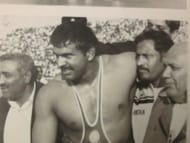
Satpal Singh's journey can be viewed as both a rebirth of Indian wrestling and the downfall of its best student. Like Mahavir Singh Phogat, "Mahabali Satpal" created a legacy of his own and was instrumental in the rise of Indian wrestling at the Olympics.
A diligent student of Guru Hanuman, Satpal rose to fame when he won a silver medal at the 1982 Commonwealth Games and a gold medal at the 1982 Asian Games. However, a lack of proper facilities prevented him from achieving ultimate glory at the Olympics, where his only appearance was in Moscow 1980.
After he retired from competitive wrestling, Satpal focused on training the next generation, just like Pullela Gopichand did for Indian badminton. His efforts paid off at the Beijing Olympics when his pupil, Sushil Kumar Solanki, bagged a bronze medal in the 66kg category. Though his other student, Yogeshwar Dutt, was eliminated in the quarterfinals, he continued to follow his guru diligently and soon won bronze at the London Olympics in 2012.
Today, as Indian wrestling is once again in the news, a significant credit behind it goes to Satpal Singh, who did as a coach what he couldn't as a player. Sadly, one of his best students, Sushil Kumar, has recently tarnished his legacy.
